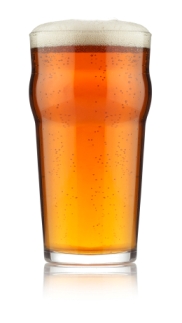
India Pale Ale (or IPA) is a popular staple of homebrewers, microbrewers and hopheads who enjoy brewing some of the hoppiest beers on the planet. This week we look at India Pale Ale beer recipes, how to brew an IPA recipe and its history.
History
According to Wikipedia, India Pale Ale traces its origins to the 17th century in England with the earliest pale ales. In fact, new malting techniques developed at the start of the 17th century using coke-fired as opposed to wood-fired kilns enabled production of the first pale malts, and subsequently paler beers. One of the popular pale styles was a beer called October beer, which was highly hopped and designed to be stored for an extended period. Note that this October beer bears no relation to German Oktoberfest beer.
George Hodgson, owner of Bow Brewery brewed a version of October beer that was popular among the traders of the East India Trading Company in the late 1700’s. East India traders subsequently started trading many of Hodgson’s beers including his October beer. The highly hopped, high gravity, highly attenuated pale ale actually benefitted from the long trip to India and became popular with consumers there.
Other brewers, including several large Burton breweries like Bass, Alsop and Salt lost their European export market in Russia due to new high tarrifs on beer. They quickly emulated the October beer of Bow Brewery and also started exporting to India. The style, which now was now commonly called “India Pale Ale” became popular in England as well around 1840.
The IPA Beer Style
IPA is a hoppy, fairly strong pale ale traditionally brewed with English malt, hops and yeast. The American version has a slightly more pronounced malt flavor and uses American ingredients. The BJCP style guide for 2008 places original gravity at between 1.050 and 1.075, and highly attenuating yeasts are used to drive a final gravity between 1.010 and 1.018 for 5-7.5% alcohol by volume.
Multiple hop additions dominate the flavor profile in IPAs. English IPA’s typically have 40-60 IBUs, though the slightly stronger imperial IPA versions can have hop rates as high as 120 IBUs.
Color is similar to many pale ales – golden to deep copper color – varying between 8-14 SRM for the finished beer. Moderate carbonation is often used, though some English IPAs are lightly carbonated.
Brewing an IPA
Hops dominate the flavor of an IPA, so careful selection of the hop additions is critical to success. Traditional English IPAs use popular English hops such as Fuggles, Goldings, Northdown, Target, though sometimes noble hops are also used in finishing. Higher alpha English hops are also popular for bittering. American IPAs use the rough American equivalents such as Cascade, Centennial, Williamette, though again higher alpha hops are often used in bittering.
Multiple hop additions are almost always used for IPAs including bittering hops at the beginning of the boil, often several additions of finishing hops in the last 5-15 minutes of the boil, and dry hops to provide a hoppy aroma. In general, higher alpha hops are used for the base boil addition while aromatic lower alpha hops are used in finishing and dry hopping, though some traditional IPAs use lower alpha English hops throughout.
Traditional English 2-row pale malt makes up the bulk of the grain bill (or two row American malt for the American IPA), usually around 85-90% of the total. Crystal and caramel malts are traditionally used to add color and body to achieve the desired overall color both in extract and all-grain recipes.
Chocolate and black malts are not often used in commercial examples though they occasionally make their way into home-brewed recipes. Personally I prefer moderately colored caramel/crystal malt. Occasionally you will see wheat, flaked barley or carapils malt added to enhance body, though these are rarely used and only in small quantities.
As many IPAs were first brewed in the English city of Burton, they share much with their English Pale Ale cousins, including the unusual Burton water profile which accentuates the hoppy profile. The Burton water profile has extremely high concentrations of calcium carbonate and bicarbonate. Depending on your local water source, a small addition of Gypsum (CaSO4) can sometimes help to simulate the hop-enhancing high carbonate Burton waters.
IPAs are most often made with traditional English ale yeasts, though care must be taken to choose a highly attenuating yeast and avoid some of the lower attenuating, fruity British ale yeasts. Many brewers bypass the problem entirely by choosing a highly attenuating American or California ale yeast for a cleaner finish.
All grain IPAs should be mashed at a lower temperature than pale ales to achieve the high attenuation desired. A mash temperature around 150F for 90 minutes will aid in breaking down more complex sugars for a clean finish that accentuates the hops.
IPAs are fermented and stored at the traditional ale temperatures, usually around the mid 60’s F. Long storage periods are sometimes required to achieve the proper hop-malt balance.
http://beersmith.com/blog/2009/09/13/brewing-india-pale-ale-recipes-ipa-beer-styles/
by
No comments:
Post a Comment